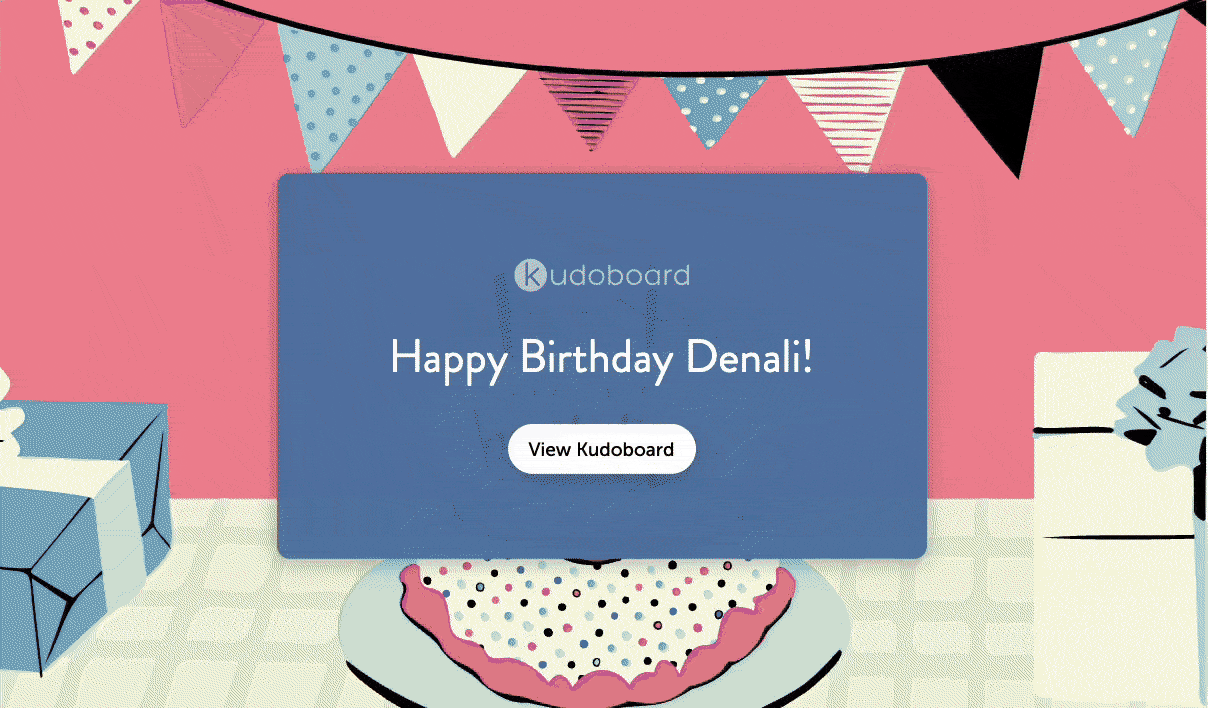Let’s imagine that you just wrapped up a major project, pulled a few late nights, and finally hit your goal. You open your inbox and there it is—a two-sentence email from your manager that says, “Thanks. Nice job.” Cue the slow clap.
While the intention may be genuine, a three-word message of appreciation over email may feel disproportionately simple after the month of hard work you just put in. A message like this might not make you feel appreciated. It is moments like those described above, where we see that it isn’t just about expressing gratitude, but equally about how you say it.
Employee recognition isn’t just about checking a box or tossing around the occasional “thank you.” It’s about expressing gratitude in a format that helps people feel seen, appreciated, and motivated to keep doing great work.
In this article, we will explore various employee appreciation formats, with an emphasis on eCards and emails, and examine the crucial role format plays in recognition culture.
Let’s dig in.
The Benefits of Employee Recognition
To understand why format matters in employee recognition, we must first understand its benefits. Although it may seem like an emphasis on appreciation is a distraction or a waste of resources, it is actually incredibly vital to a company’s overall success. When companies invest in their people and employee experience, they will thrive.
Here are some of the ways employee appreciation benefits an organization:
- Builds employee engagement: Recognition helps employees feel connected to their work and their team. Humans like to know their work is worthwhile, and when they do, they are more likely to want to continue doing the job. Recognition is the perfect way to demonstrate to an employee that their work matters, which in turn increases employee engagement.
- Reduces employee turnover: Feeling unseen is a top reason employees leave organizations. Consistent recognition reassures employees that their efforts are appreciated, encouraging employee loyalty and improving employee retention.
- Improves team collaboration: Recognition promotes a sense of mutual respect. Peer-to-peer recognition, in particular, enhances collaboration and improves interpersonal relationships within teams. When employees feel like their coworkers appreciate what they are doing, they are more likely to come together to find solutions.
- Increases productivity: Recognition encourages repeat performance. Employees who are acknowledged for specific achievements are going to want to continue producing that same high-quality work. It also helps workers overcome feelings of frustration and improve productivity levels.
- Reinforces values and culture: When recognition is aligned with company values—like teamwork, innovation, or customer service—it helps strengthen the behaviors and attitudes that define your company culture.
- Improves Employee Satisfaction: Employees who feel appreciated are more likely to be satisfied with their jobs. Therefore, words of gratitude can significantly enhance job satisfaction, making your workplace a more enjoyable place to be.
eCards or Emails: Which is Better?

Emails have been a workplace staple for decades, and for good reason—they’re quick, convenient, and familiar. But when it comes to employee recognition, email often falls flat. A simple “thanks for your help” buried between budget updates and meeting invites doesn’t exactly inspire lasting appreciation.
eCards, by contrast, are designed for ease and impact. They can be more than just a message, offering versatile visual and delivery options, as well as group contributions.
Let’s break down why eCards offer a better recognition experience and where emails come up short.
Why eCards Win
They capture attention: Inboxes are cluttered, and even the most thoughtful email can get lost in the mix. eCards stand out with their colorful designs, animations, and unique formatting, which immediately catch the eye.
- They’re emotionally engaging: Recognition is about making someone feel valued. eCards allow for creativity—images, GIFs, emojis, and heartfelt notes from multiple people all work together to create an emotionally rich experience. In the end, the recipient will receive a more personalized and heartfelt gift.
- They encourage team participation: Most digital card platforms allow multiple contributors to sign one card. Making a group card makes it easy to gather messages from an entire team, department, or even the whole company. It transforms appreciation into social recognition as a team-wide celebration.
- They offer personalization: From design to messaging, eCards provide a level of customization that email cannot. Employees can receive a card with inside jokes, favorite colors, custom backgrounds, or personalized images, making it more than just a “good job” message.
- They create lasting memories: Unlike emails that are quickly read and archived, eCards are keepsakes. Employees can download them, revisit the messages, or even print them. That staying power reinforces the value of the recognition long after the moment has passed.
- They work for remote and hybrid workplaces: eCards are accessible from anywhere, making them ideal for distributed teams. Everyone—from interns to executives—can join in, no matter where they’re working.
- They align with modern work culture: Today’s employees, especially younger generations, value personalization, technology, and visual communication. Digital greeting cards cater to those preferences, offering a more human and relatable way to connect.
- They’re great for a multitude of occasions. Digital cards are versatile, as they can be used to celebrate employee milestones, holidays, and corporate initiatives.
Where Emails Fall Short
While email recognition can still play an important part in employee recognition programs, it has real limitations that are hard to ignore in today’s workplace. Some of these reasons include:
- They’re easy to overlook: Most inboxes are overflowing. A quick thank-you is likely to be skimmed or missed entirely.
- They lack personalization: Even a thoughtful email can feel generic when it follows the same formula every time.
- They’re one-to-one, not team-based: Unless you loop in others, recognition via email is private. It misses the opportunity to bring in team voices or amplify the moment.
- They aren’t visually engaging: Emails are text-heavy and uniform. There’s little room for creativity or fun, which limits the emotional impact.
- They’re forgettable: Once an email is read, it’s rarely revisited. The message fades quickly, and so does the sense of appreciation.
The Bottom Line
If your goal is to create moments of recognition that feel meaningful, memorable, and shared, eCards are the clear winner. They transform a simple appreciation into a celebration, ensuring that employees understand the impact their work has.
Why Format Matters in Employee Recognition

It’s easy to assume that saying thanks is enough. But how that message is delivered can make the difference between a moment that’s remembered and one that’s forgotten.
For example, expressing appreciation for someone’s positive outlook can be done casually and meaningfully. Whereas someone who is retiring after 30 years at the company shouldn’t celebrate via a goodbye email, but rather with a party, gift, or group card full of retirement wishes from their colleagues.
Here are reasons why the format you choose for employee appreciation matters:
Emotional Impact
The format of recognition affects how it is received emotionally. A plain-text email might check the box, but it often lacks emotional depth. In contrast, a visually designed group card with team messages feels more intentional and heartfelt. Choosing the correct format for big moments versus simple ones can make the appreciation more meaningful.
Visibility
Some formats are private, while others are public or shareable. Determining whether gratitude should be displayed on a recognition wall, in an internal newsletter, or on a digital feed, or whether it should be conveyed in a one-on-one meeting, will ensure the message is received as intended.
Effort Perception
Employees notice effort. If all the recognition an employee receives is a quick thank you or an employee reward badge, they might feel like the recognition doesn’t mean anything. Therefore, using formats that require more effort throughout an employee recognition program can keep it feeling fresh and sincere.
Reflects Company Culture
The format you choose reveals a lot about your organization. Recognition delivered through the right format reinforces your company’s values, tone, and identity. Using a format that mirrors your company’s voice helps employees connect with the message and with each other. It demonstrates consistency between what your organization claims to value and how it actually behaves.
When the format matches the company culture, recognition feels more authentic, and employees are more likely to engage with and appreciate it.
Format Influences Participation
The easier and more enjoyable it is to give recognition, the more likely people are actually to do it. Format plays a big role in whether recognition becomes part of the everyday culture or remains an occasional gesture.
A clunky process—like drafting a formal email or filling out a lengthy form—can discourage people from taking the time to acknowledge others. On the other hand, fun and intuitive formats, such as group cards with Kudoboard, make it simple for anyone, at any level, to participate.
Whether it’s a peer giving a shoutout or a team celebrating a milestone, a user-friendly format encourages more frequent, widespread recognition across the organization.
Common Formats for Employee Recognition
The great thing about employee appreciation is that it comes in a variety of formats that you can tailor to the specific needs of the situation. Each of these types has its particular strengths and uses. Here are the most common formats and when to use them:
Emails
What it is: A written message, usually from a manager or colleague, expressing appreciation and sent directly to the employee’s inbox.
When to use:
- For individual, private messages of thanks
- When a quick note of appreciation is needed
- When no formal recognition platform is available
eCards
What it is: A digital card—often created and signed by multiple people—that can include messages, images, animations, and sometimes videos.
When to use:
- For celebrations like birthdays, promotions, or employee milestones
- For peer recognition
- To recognize team achievements
- As part of a larger employee recognition program
In-Person Recognition
What it is: Verbal recognition offered during meetings, events, or one-on-one conversations.
When to use:
- To provide spontaneous, direct praise
- During team meetings or events
- When personal interaction is possible
Tangible Awards and Gifts
What it is: Physical tokens like plaques, gift cards, employee rewards, or bonuses that are tied to employee achievements or milestones.
When to use:
- For formal staff recognition, like Employee of the Month
- For tenure awards or project completions
- To recognize exceptional employee performance
Employee Recognition Software
What it is: A dedicated platform that allows companies to automate, track, and scale employee recognition programs. Often includes features like group cards, points-based systems, leaderboards, and badges.
When to use:
- Across larger or distributed teams
- To track recognition trends
- To align recognition with company values or goals
- For gamified or points-based recognition
How to Know Which Employee Recognition Format to Choose
With so many ways to recognize employees—emails, eCards, in-person shoutouts, software platforms, and physical rewards—it can be tricky to know which format fits best. The good news? You don’t need a one-size-fits-all approach. Instead, include a variety of methods in your recognition toolbox.
The key is choosing the right format for the moment, the message, and the employee.
To do this, start by thinking about the type of recognition you’re giving. Is it a quick thank-you for helping with a task, or a milestone moment, such as a work anniversary or promotion? For quick, informal recognition, a peer-to-peer eCard or short message might be perfect. For more significant employee accomplishments, consider something more visible or lasting, like a team-signed group card, a formal award, or recognition shared at a meeting.
Next, consider the audience. Is this recognition meant to be private or public? If it’s a personal message, email may be the most appropriate option. If you want to inspire others or boost employee morale across a team, choose a format that allows for visibility, such as an employee shout-out wall or a post in your recognition platform’s social feed.
Additionally, consider the employee’s preferences. Some people love public recognition and group celebrations, while others may prefer more low-key, one-on-one appreciation. Matching the format to the person ensures the message lands well and feels authentic.
Finally, take into account your workplace environment. In-person praise is great for on-site teams, but doesn’t always work for remote or hybrid models. Digital formats, such as eCards, provide a consistent and inclusive way to ensure that every employee—regardless of their location—feels seen and celebrated.Email may still have its place for quick, private notes, but for recognition that sticks? eCards do it better—visually, emotionally, and conveniently.
When to Use Group Cards for Recognition

Birthdays and Anniversaries: Use group cards to celebrate personal and professional milestones. Group cards from colleagues help employees feel celebrated beyond a simple “happy birthday” email.
Promotions and New Roles: Make a new title feel even more special with a congratulatory group card from leaders and peers alike.
Farewells and Retirements: Group cards become a keepsake that departing employees can treasure, filled with personal messages and good wishes.
Welcome and Onboarding: Send a welcome card to new hires signed by their future team. It creates an immediate sense of inclusion and warmth.
Project Completion: After finishing a major project, recognize the effort with a team group card. Each contributor can express gratitude and share highlights.
Peer-to-Peer Shoutouts: Encourage team members to send spontaneous appreciation to one another. eCards make the gesture more meaningful than a simple Slack message or email.
Moving Beyond Email: How to Make the Switch
If your company still relies heavily on email for recognition, moving to digital group cards or eCards doesn’t have to be complicated. Making the switch to e cards doesn’t require a complete overhaul—just a more intentional and thoughtful approach to appreciation.
First, start small by identifying the recurring moments that already call for recognition. Birthdays, work anniversaries, promotions, onboarding, and farewells are all natural opportunities to send an eCard instead of an email. Then, choose an eCard platform, like Kudoboard, that fits your company’s needs and makes it easy for people to participate.
Next, as you introduce eCards, encourage your managers and team leads to lead the way. When leaders model regular recognition by sending and signing eCards, it sets a precedent for others to follow.
It’s also worth listening to employee feedback during the transition. Ask what kinds of recognition feel most meaningful to them. You may find that some employees prefer public messages, while others appreciate more low-key acknowledgments. The beauty of eCards is that they offer flexibility—you can tailor the tone and visibility to match the moment and the individual.
Ultimately, moving beyond email is about being more intentional. Recognition shouldn’t feel like just another message in a crowded inbox. It should feel like a moment created with care and purpose. With e cards, you can make recognition more fun, more collaborative, and far more memorable—without making it more complicated.
Final Thoughts
Employee recognition matters—but how it’s delivered matters just as much. While email may be convenient, it often falls short in creating lasting, emotional, or visible moments of appreciation.
If you’re ready to upgrade how you celebrate your employees, Kudoboard makes it easy to create beautiful, team-signed group cards for birthdays, milestones, and everyday appreciation. With customizable designs, multimedia options, and simple collaboration, Kudoboard turns recognition into a shared, meaningful experience.
Start your next celebration with Kudoboard and give your team the recognition they deserve.
Upgrade from emails to eCards.
Try Kudoboard for recognition that actually sticks.




